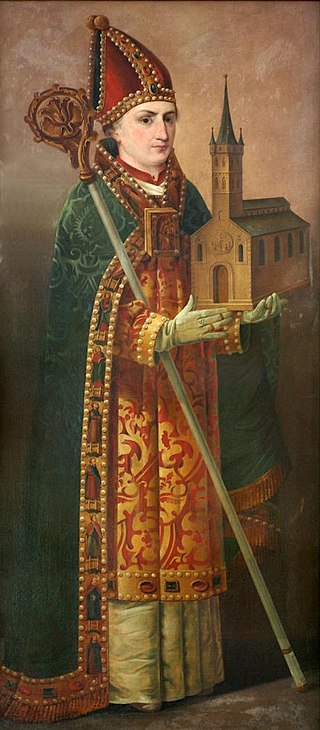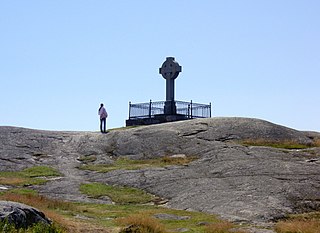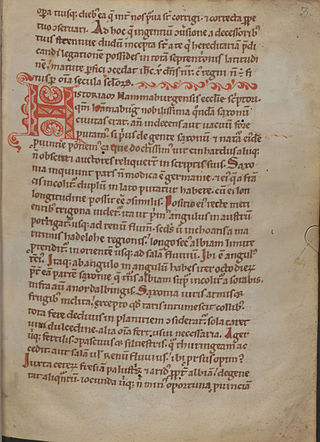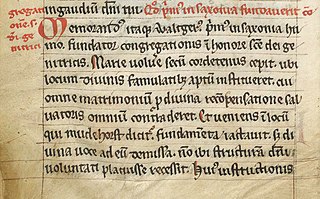Related Research Articles

Ansgar, also known as Anskar, Saint Ansgar, Saint Anschar or Oscar, was Archbishop of Hamburg-Bremen in the northern part of the Kingdom of the East Franks. Ansgar became known as the "Apostle of the North" because of his travels and the See of Hamburg received the missionary mandate to bring Christianity to Northern Europe.

Birka, on the island of Björkö in present-day Sweden, was an important Viking Age trading center which handled goods from Scandinavia as well as many parts of the European continent and the Orient. Björkö is located in Lake Mälaren, 30 kilometers west of contemporary Stockholm, in the municipality of Ekerö.
Ratramnus a Frankish monk of the monastery of Corbie, near Amiens in northern France, was a Carolingian theologian known best for his writings on the Eucharist and predestination. His Eucharistic treatise, De corpore et sanguine Domini, was a counterpoint to his abbot Paschasius Radbertus’s realist Eucharistic theology. Ratramnus was also known for his defense of the monk Gottschalk, whose theology of double predestination was the center of much controversy in 9th-century France and Germany. In his own time, Ratramnus was perhaps best known for his Against the Objections of the Greeks who Slandered the Roman Church, a response to the Photian schism and defense of the filioque addition to the Niceno-Constantinopolitan Creed.
The Vita Ansgarii, also known as the Vita Anskarii, is the hagiography of saint Ansgar, written by Rimbert, his successor as archbishop in the Prince-Archbishopric of Bremen. The Vita is an important source not only in detailing Ansgar's Scandinavian missionary work, but also in its descriptions of the everyday lives of people during the Viking Age.
Olof was a Swedish monarch or local ruler who ruled over Birka, an important port town, and possibly Uppsala, an important early Swedish political center, in about 852, when the Catholic missionary Saint Ansgar made his second voyage from Germany to Birka in about the year 851 or 852 A.D. He had an ambivalent attitude to Christianity, and was known as a successful warrior king in the Baltic region.

The House of Munsö, also called the House of Björn Ironside, the House of Uppsala or simply the Old dynasty, is the earliest reliably attested royal dynasty of Sweden, ruling during the Viking Age. None of the names suggested for the dynasty are universally accepted and most are problematic; the name "House of Munsö" derives from a questionable and speculative theory that they would have ruled from the island of Munsö and the name "House of Björn Ironside" derives from the supposed founder of the dynasty, Björn Ironside, who is often seen as a legendary, rather than historical, figure.

Saint Sigfrid of Sweden (Swedish: Sigfrid, Latin: Sigafridus, Old Norse: Sigurðr, Old English: Sigefrið/Sigeferð) was a missionary-bishop in Scandinavia during the first half of the 11th century. Originally from England, Saint Sigfrid is credited in late medieval king-lists and hagiography with performing the baptism of the first steadfastly Christian monarch of Sweden, Olof Skötkonung. He most likely arrived in Sweden soon after the year 1000 and conducted extensive missions in Götaland and Svealand. For some years after 1014, following his return to England, Sigfrid was based in Trondheim, Norway. However, his position there became untenable after the defeat of Olaf Haraldsson.
Adalgar, venerated as Saint Adalgar, was the third archbishop of Bremen from 888 until his death. Adalgar is revered as a saint in the Roman Catholic and Eastern Orthodox Churches. His feast day is 29 April.

The Christianization of Scandinavia, as well as other Nordic countries and the Baltic countries, took place between the 8th and the 12th centuries. The realms of Denmark, Norway and Sweden established their own archdioceses, responsible directly to the pope, in 1104, 1154 and 1164, respectively. The conversion to Christianity of the Scandinavian people required more time, since it took additional efforts to establish a network of churches.

Gesta Hammaburgensis ecclesiae pontificum is a historical treatise written between 1073 and 1076 by Adam of Bremen, who made additions (scholia) to the text until his death . It is one of the most important sources of the medieval history of Northern Europe, and the oldest textual source reporting the discovery of coastal North America.

Horik I or Hårik was a king of the Danes. He was co-ruler from 813, and sole king from c. 828 until his violent death in 854. His long and eventful reign was marked by Danish raids on the Carolingian Empire of Louis the Pious, son and successor of Charlemagne.
Saint Unni was an archbishop of Hamburg-Bremen. He died as a missionary in Birka in Sweden, where he tried to continue Ansgar's work.
Ansgar (801–865) was an Archbishop of Hamburg-Bremen.

Horik II, also known as Hårik or, in late sources, Erik Barn, was King of the Danes from the fall of Horik I in 854 to an unknown date between 864 and 873. During his reign the Danish kingdom showed tendencies of breaking up. After his demise under unknown circumstances, Denmark entered a long period of obscurity, until the rise of the Jelling dynasty in the 10th century.
Apostle of the North is a term applied to several religious people:
The history of Christianity in Denmark started with Saint Willibrord's unsuccessful mission among the Danes in the early 8th century.

The Battle of Norditi, Battle of Nordendi or Battle of Hilgenried Bay was a battle between a Frisian army under Archbishop Rimbert of Bremen-Hamburg and an army of Danish Vikings in 884, which resulted in the complete withdrawal of the Vikings from East Frisia.
Björn was a Swedish monarch or local ruler who ruled over Birka, an important port town, and possibly Uppsala, an important early Swedish political center, around the year 829. His existence is attested by the nearly contemporary account Vita Ansgari, written by the missionary Rimbert, who visited Sweden alongside Ansgar in c. 852. He is in fact the first Swedish figure referred as king who is known from a reasonably reliable source. Older Swedish historiography often identified the king with the legendary figure Björn at Haugi, who was supposedly a Swedish ruler in the generation before the youth of Harald Finehair of Norway. This identification is however considered unverifiable, since Björn at Haugi may have actually been a Norwegian local ruler who was later constructed as a Swedish king. Although the genealogy of early Swedish local rulers is not known, Björn is assumed to have belonged to the House of Munsö, which would later produce Eric the Victorious, generally considered to be Sweden's first king. The royal names attested in the ninth century, namely, also occur among the kings and princes in the late Viking age, perhaps suggesting a genealogical continuity.
Eric was a Swedish monarch or local ruler who ruled over Birka, an important port town, and possibly Uppsala, an important early Swedish political center, and is mentioned as dead by 852. His existence is attested by the nearly contemporary account Vita Ansgari, written by the missionary Rimbert, who visited Sweden alongside Ansgar in c. 852. By the time of their visit, a king by the name Olof ruled, with Eric being deceased since a while.

Waltger was a Saxon nobleman who founded Herford Abbey in the 830s. In 838, he gave the monastery to the Emperor Louis the Pious, who in turn placed it under the authority of the Benedictine nunnery of Notre-Dame de Soissons.
References
- 1 2 3 4 5 6 7 Palmer, James (2004). "Rimbert's Vita Anskarii and Scandinavian Mission in the Ninth Century". The Journal of Ecclesiastical History. 55 (2): 235–256. doi:10.1017/S0022046904009935. hdl: 10023/1554 – via JSTOR.
- ↑ Wickham, Chris (2006). Framing the Early Middle Ages: Europe and the Mediterranean, 400-800. Oxford: Oxford University Press. p. 366. ISBN 9780199212965.
- 1 2 3 4 5 6 7 8 Knibbs, Eric (2011). Ansgar, Rimbert, and the Forged Foundations of Hamburg-Bremen. Surrey: Routledge. ISBN 9781409428824.
- 1 2 Winroth, Anders (2012). The Conversion of Scandinavia Vikings, Merchants, and Missionaries in the Remaking of Northern Europe. Yale University Press. ISBN 9780300205534.
- ↑ Herbermann, Charles, ed. (1913). . Catholic Encyclopedia . New York: Robert Appleton Company.; Erik Gustaf Geijer, Geschichte Schwedens [Svenska folkets historia; German]: 6 vols., Swen Peter Leffler (trl., vols. 1-3), Friedrich Ferdinand Carlson (trl., vols. 4-6) and J. E. Peterson (co-trl., vol. 4), Hamburg and Gotha: Friedrich Perthes, 1832-1887, (Geschichte der europaeischen Staaten, Arnold Hermann Ludwig Heeren, Friedrich August Ukert, and (as of 1875) Wilhelm von Gieselbrecht (eds.); No. 7), vol. 1 (1832), p. 121. No ISBN.
- 1 2 Ottewill-Soulsby, Sam (2021). "City of Dog". Journal of Urban History. 47 (5): 1130–1148. doi: 10.1177/0096144220910139 . S2CID 216457690.
- ↑ Bruce, Scott (2005). "Hagiography as Monstrous Ethnography: A Note on Ratramnus of Corbie's Letter Concerning the Conversion of the Cynocephali". Insignis Sophiae Arcator: Medieval Latin Studies in Honour of Michael Herren on His 65th Birthday: 44–56.
- ↑ Palmer, James (2014). The Apocalypse in the Early Middle Ages. Cambridge University Press. ISBN 9781107449091.